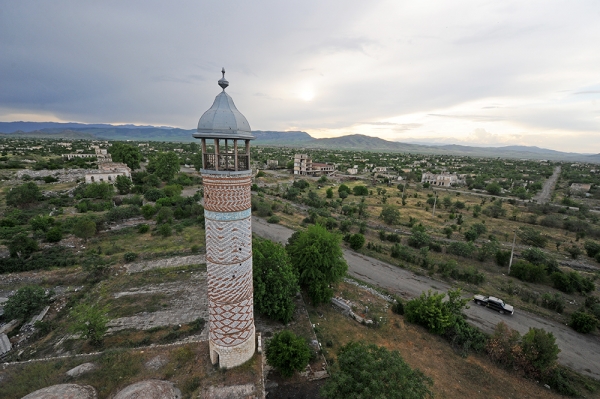Aghdam, 21 years under Armenian occupation

By Sara Rajabova
July 23 marks the occupation of one of the ancient and historical regions of Azerbaijan, Aghdam, by Armenian armed forces.
Twenty one years have passed since the invasion in Aghdam during the brutal war fought by the two South Caucasus republics in the early 1990s.
The occupation of Aghdam was the third painful blow to Azerbaijan after the invasion in Lachin and Kalbajar around Nagorno-Karabakh. As a result of the Armenian armed forces' attack on Aghdam, the town was razed to the ground.
The Armenians invaded most of Aghdam's territory on July 23, 1993. The Armenian aggressors seized 882 sq. km. of the 1,094 sq. km. territory of Aghdam, including one city and 80 villages. Some 128,000 people became internally displaced - 17,000 of them were adults.
Over 6,000 people died during the fighting in Aghdam.
About 130,000 displaced persons from Aghdam have been settled in 875 settlements of 59 regions across Azerbaijan.
Armenians destroyed historical monuments, cemeteries, hospitals, libraries, schools, offices and facilities in the occupied territory. 122 villages, around 24,000 residential buildings, 48 industrial and construction enterprises, 160 schools, 65 health centers, 373 cultural centers, 1 theater, 3 mosques and 2 museums were burnt down and completely destroyed.
Aghdam had a lot of historical architectural monuments. The Uzerlik Hill situated in the village of Khindiristan, the cupola of Gutlu Musa oglu in Khachinderbend (1314-th year), the tombs and the stone monuments in Salahli-Kengerli village (14th century), Khanoglu tomb (17th century), the mansion of Karabakh Khan Panahali and his family (18th century), the castle of Shahbulaq and others confirm that this place belongs to Azerbaijan.
However, most of the historical monuments were destroyed following Armenian occupation. They included the Khanoglu tomb (17th century), the mansion of Panahali Khan and his tomb (19th century), and the twin-minaret Aghdam Juma mosque (1870).
Armenia is still continuing to plunder Azerbaijani cultural property and violating The Hague Convention clause on the protection of cultural property during war and a provision on "illicit traffic of cultural property" in Paris Convention.
The Armenian invaders also depleted the natural resources of the region after the occupation, according to the facts revealed by a center of the Ecology and Natural Resources Ministry of Azerbaijan.
The eastern sycamore trees aged up to 400 years and other tree species were destroyed in the occupied territories and currently are about to be effaced from the world flora treasure. Arsons committed in the occupied villages of Aghdam by Armenian soldiers resulted in the perishing of various partridges, pheasants and vipers, which are included in the "Red Book" and the International Union for Conservation of Nature and Natural Resources Red List of Threatened Species.
As a result of the occupation of Aghdam, Azerbaijan sustained material damages worth a staggering $6.179 billion. The damages inflicted to the region's agriculture were alone estimated at 992.8 million manats ($1.272 billion).
Armenia occupied over 20 percent of Azerbaijan's internationally recognized territory, including Nagorno-Karabakh and seven adjacent regions, after laying territorial claims against its South Caucasus neighbor that caused a brutal war in the early 1990s. Long-standing efforts by U.S, Russian and French mediators have been largely fruitless so far.
The UN Security Council has passed four resolutions on Armenian withdrawal from the Azerbaijani territory, but they have not been enforced to this day.
